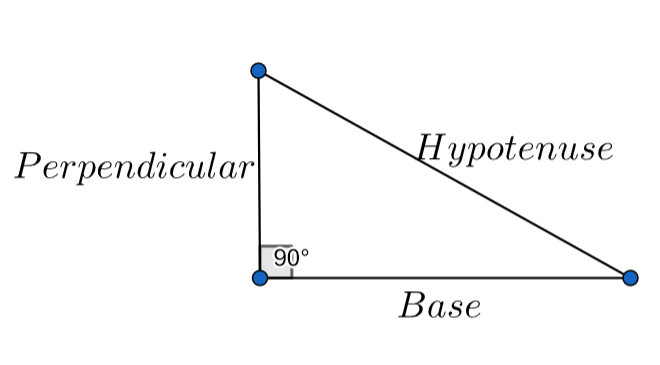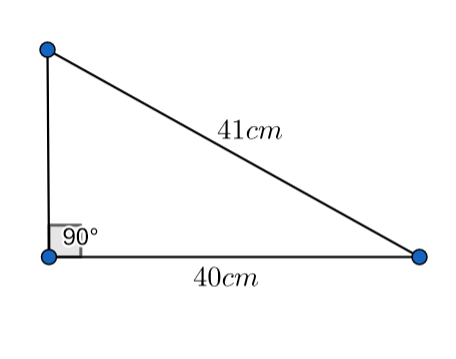
In a right angled triangle the length of the hypotenuse is 41 cm and one side is 40 cm. Find the length of the other side.
Answer
406.2k+ views
Hint: In this type of question we have to use the concept of Pythagoras theorem. We know that Pythagoras theorem explains the relation between the sides of a right angled triangle. By this theorem we can derive base, perpendicular and hypotenuse formulas. Pythagoras theorem states that, “In a right-angled triangle, the square of the hypotenuse side is equal to the sum of the squares of the two other sides”.

Complete step by step answer:
Now, we have to find the length of a side of a right angled triangle where the length of the hypotenuse is 41 cm and the length of one of the side is 40 cm.
We know that, the Pythagoras theorem states that, “In a right-angled triangle, the square of the hypotenuse side is equal to the sum of the squares of the two other sides”.
Mathematically we can express Pythagoras theorem as,
\[\Rightarrow \text{Hypotenus}{{\text{e}}^{2}}=\text{Bas}{{\text{e}}^{2}}+\text{ Perpendicula}{{\text{r}}^{2}}\]
Here, we have given that,
Hypotenuse = 41 cm
One side (Say Base) = 40 cm
Another Side (Say Perpendicular) = ?

By substituting the values in above equation, we can write,
\[\Rightarrow {{41}^{2}}={{40}^{2}}+\text{ Perpendicula}{{\text{r}}^{2}}\]
On Simplifying we get,
\[\begin{align}
& \Rightarrow 1681=1600+\text{ Perpendicula}{{\text{r}}^{2}} \\
& \Rightarrow 1681-1600=\text{Perpendicula}{{\text{r}}^{2}} \\
& \Rightarrow 81=\text{Perpendicula}{{\text{r}}^{2}} \\
\end{align}\]
By taking square root of both the sides we get,
\[\Rightarrow 9=\text{ Perpendicular}\]
Hence, the length of another side is 9 cm.
Note: In this type of question students have to remember the Pythagoras theorem for right angled triangles. Also students have to note that the side opposite to the angle \[{{90}^{\circ }}\] is called the hypotenuse, and the sides which formed the right angle are known as base and perpendicular.

Complete step by step answer:
Now, we have to find the length of a side of a right angled triangle where the length of the hypotenuse is 41 cm and the length of one of the side is 40 cm.
We know that, the Pythagoras theorem states that, “In a right-angled triangle, the square of the hypotenuse side is equal to the sum of the squares of the two other sides”.
Mathematically we can express Pythagoras theorem as,
\[\Rightarrow \text{Hypotenus}{{\text{e}}^{2}}=\text{Bas}{{\text{e}}^{2}}+\text{ Perpendicula}{{\text{r}}^{2}}\]
Here, we have given that,
Hypotenuse = 41 cm
One side (Say Base) = 40 cm
Another Side (Say Perpendicular) = ?

By substituting the values in above equation, we can write,
\[\Rightarrow {{41}^{2}}={{40}^{2}}+\text{ Perpendicula}{{\text{r}}^{2}}\]
On Simplifying we get,
\[\begin{align}
& \Rightarrow 1681=1600+\text{ Perpendicula}{{\text{r}}^{2}} \\
& \Rightarrow 1681-1600=\text{Perpendicula}{{\text{r}}^{2}} \\
& \Rightarrow 81=\text{Perpendicula}{{\text{r}}^{2}} \\
\end{align}\]
By taking square root of both the sides we get,
\[\Rightarrow 9=\text{ Perpendicular}\]
Hence, the length of another side is 9 cm.
Note: In this type of question students have to remember the Pythagoras theorem for right angled triangles. Also students have to note that the side opposite to the angle \[{{90}^{\circ }}\] is called the hypotenuse, and the sides which formed the right angle are known as base and perpendicular.
Recently Updated Pages
What percentage of the area in India is covered by class 10 social science CBSE

The area of a 6m wide road outside a garden in all class 10 maths CBSE

What is the electric flux through a cube of side 1 class 10 physics CBSE

If one root of x2 x k 0 maybe the square of the other class 10 maths CBSE

The radius and height of a cylinder are in the ratio class 10 maths CBSE

An almirah is sold for 5400 Rs after allowing a discount class 10 maths CBSE

Trending doubts
The Equation xxx + 2 is Satisfied when x is Equal to Class 10 Maths

Why is there a time difference of about 5 hours between class 10 social science CBSE

Change the following sentences into negative and interrogative class 10 english CBSE

Write a letter to the principal requesting him to grant class 10 english CBSE

Explain the Treaty of Vienna of 1815 class 10 social science CBSE

Write an application to the principal requesting five class 10 english CBSE




